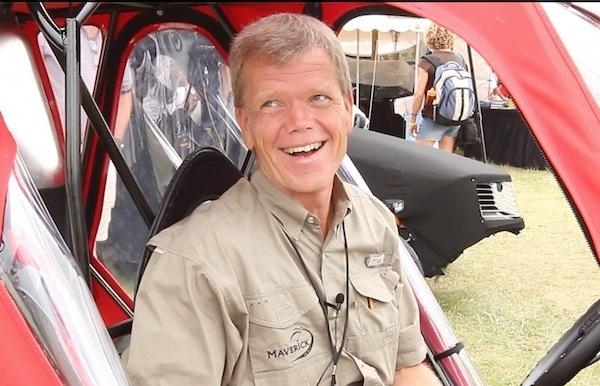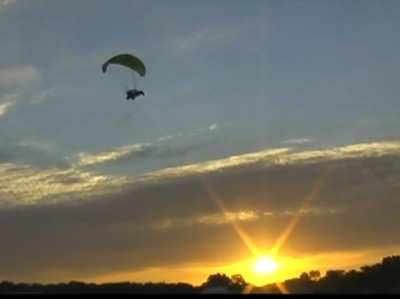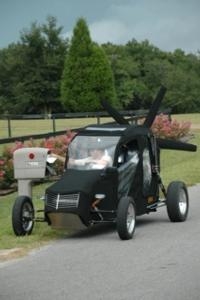Maverick Flying Car Is Street-Legal, But Also Goes 'Off
Road'
By Chris Batcheller
Steve Buer, Production Manager for the Maverick Flying Car was
proud to show off the first and second and production models on
display in the Maverick Flying Car Booth. Also on display was the
production prototype. Steve said two more vehicles are in
production back in Florida.
 Steve Buer
Steve Buer
The Maverick is the only flying car currently in production. The
design grew form a need for transportation in rugged areas to
perform missionary work. Steve Saint identified many of the primary
requirements for a successful frontier vehicle: it must be rugged
and easy to service in remote areas, use widely available
automotive fuel, and be able to fly over terrain when the roads
inevitably fail. The Maverick is designed to meet - and exceed -
these requirements, and do so in an efficient and straightforward
manner.
The Maverick has dual drive and holds 17 gallons of fuel. It is
equipped with a 2.5L Subaru 190 hp engine that is fuel injected and
water cooled. It has a welded steel tube frame for lightweight
construction and long-throw ground suspension with high performance
shocks.

In flight mode the top speed is around 40 mph and the climb rate
is 900 fpm and a service ceiling of 10,000 feet. The takeoff and
landing distance is around 300 feet. The useful load is up to 700
lbs. In the road configuration, the Maverick can accelerate to 60
mph in 3.9 seconds and gets approximately 25 mpg.
“It’s been a unique project,” says chief
mechanic Steve Buer. “The dynamic between creating a
car that is durable yet light enough to fly has been the challenge;
to make it strong enough to take the abuse on the road but light
enough to get off the ground.“
“The heart of this vehicle is going to be humanitarian
aid,” says Steve Saint, who founded Itec, Indigenous
People’s Technology & Education Center and is the
imagineer behind the Maverick. “We developed a vehicle
that an average person can use at the end of the road and beyond
roads to change people’s lives.”

At EAA AirVenture, the keys to the first Maverick off the
production line were presented to its new owners. Ywam
Medical Ships, a Christian organization, which meets medical needs
in remote locations all over the world, plans to field test the
Maverick to show how the unit can be used to meet humanitarian
needs beyond roads. The team of driver/pilots plan to cross
the United States, head down thru Central America, and to
Australia.
“We’re excited that the YWAM team will be taking the
flying car on a road trip, and putting the Maverick to the
test,” said Troy Townsend, primary test pilot for the
Maverick. “It’s unbelievable how
‘car-like’ it is in the air. We continually want
to improve the design so that it is useful to indigenous people
throughout the world. We feel this project has the
possibility of changing lives for people who live in frontier
areas.” A team is documenting the adventure trip, which
will be featured on Grassrootsnews.tv
The Maverick can be used in many situations that typically use a
helicopter, which is costly to operate. Itec envisions that
the Maverick will be useful to ranchers, conservation departments
checking wetlands, disaster relief, short-range transportation in
flooded areas, to name a few possibilities. Maverick engineers are
currently working on float adaptation that will allow the Maverick
flying car to operate on water, snow and ice.
As of September 28, 2010, the Maverick is S-LSA Certified. The
Special Light Sport Airworthiness Certificate was issued by the
Orlando MIDO office of the FAA. In June 2011, the FAA granted a
gross weight exemption to 1,430 lbs (S-LSA).
The Maverick is approved by the Florida DMV and licensed under
kit-car regulations. It may be driven on any public road in the
USA.
 ANN's Daily Aero-Linx (04.15.24)
ANN's Daily Aero-Linx (04.15.24) Classic Aero-TV: 'No Other Options' -- The Israeli Air Force's Danny Shapira
Classic Aero-TV: 'No Other Options' -- The Israeli Air Force's Danny Shapira Aero-News: Quote of the Day (04.15.24)
Aero-News: Quote of the Day (04.15.24) Airborne 04.16.24: RV Update, Affordable Flying Expo, Diamond Lil
Airborne 04.16.24: RV Update, Affordable Flying Expo, Diamond Lil ANN's Daily Aero-Term (04.16.24): Chart Supplement US
ANN's Daily Aero-Term (04.16.24): Chart Supplement US





